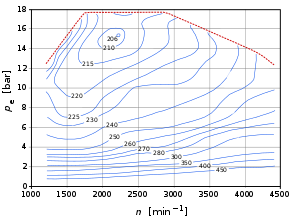Consumption map
The consumption map , also known as the shell diagram , shell curve or efficiency map, represents the specific fuel consumption over the effective mean pressure and the speed of an internal combustion engine .
The map is limited on the abscissa by the minimum and maximum speed and on the ordinate by the full load curve of the internal combustion engine. Lines with the same specific fuel consumption form a shell pattern, hence the name “shell diagram”. The speed is usually given in revolutions per minute (1 / min; min −1 ), instead of the mean pressure, the torque can also be plotted and the consumption can be given in g / kWh (in older literature also g / PSh) or as efficiency (η ) can be specified in percent.
For example, the resulting specific fuel consumption can be read from the map for every possible combination of engine speed and mean effective pressure. It can be seen from this that, apart from the maximum output, several operating points with different fuel consumption are possible for each required engine output P (which is proportional to ).
The consumption map also provides information about the efficiency of an engine if the type of fuel is taken into account. So a spec. Fuel consumption of 210 g / kWh approx. 40% efficiency with diesel and petrol, with natural gas this efficiency is achieved at 200 g / kWh.
Typical peak values in the best point are:
- 160–180 g / kWh for slow-running 2-stroke marine diesel engines in heavy oil operation (up to approx. 55% efficiency, speeds below 300 / min, combined diesel-steam process.);
- 210–195 g / kWh for diesel cars with charging and charge air cooling;
- 225–195 g / kWh for trucks with charging and charge air cooling;
- 350–250 g / kWh for naturally aspirated passenger car engines with petrol.
Efficiency
In motorized applications, only the calorific value is relevant. If the specific energy of the fuel ( ) and the specific fuel consumption of the machine ( ) are known, the effective (useful) efficiency can be calculated.
Example: petrol or diesel has a calorific value of around 11.6 kWh / kg; if a car engine has a consumption of around 0.22 kg / kWh at the best point, this results in the following efficiency:
- so: 1 / (11.6 × 0.22) = 39%
literature
- Richard van Basshuysen / Fred Schäfer (eds.): Handbook Internal Combustion Engine: Fundamentals, Components, Systems, Perspectives , 3rd edition 2005, Vieweg + Teubner Verlag.
Individual evidence
- ↑ Dieter Lohse and Werner Schnabel: Basics of road traffic engineering and traffic planning : Volume 1 , Beuth Verlag, 2011, ISBN 9783410172710 .
- ↑ Rainer Golloch, "downsizing diesel engines" , Section 2.1.3 combustion , 1st edition 2005, Springer, ISBN 3-540-23883-2 .
- ↑ according to table 1 in Konrad Reif, “Diesel engine management at a glance” , section Springer Fachmedien Wiesbaden 2014, ISBN 978-3-658-06554-6 .




